Wheel World is an open-world bicycle racing videogame with a supernatural twist. I play as Kat, a silent protagonist who discovers a rusty bicycle in a shrine on a small island. The bicycle is inhabited by Skully, a benevolent “immortal bike daemon” in the form of a skull animated by glowing green energy, who asks for Kat’s aid with an important mission. They must perform the Chain of Life, a loop where the spirits of the dead are led by a rider on a magic bicycle to the moon and back for non-specific but existentially vital reasons. The legendary bicycle parts that enable this journey have been stolen. Skully enlists Kat’s aid in recovering these parts from a gang of conceited professional bicyclists sponsored by a shady corporation. Kat and Skully must explore Wheel World, amass a huge collection of bicycle parts, compete in races and other open-world activities, and reclaim the stolen pieces to the legendary bicycle so Skully may resume guiding the spirits of the dead on their journey.
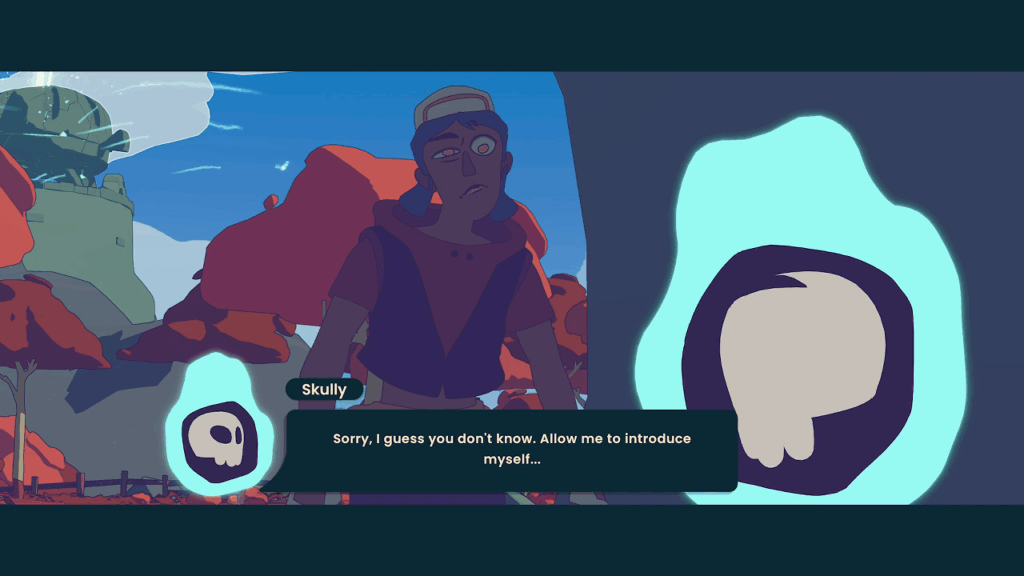
Wheel World has exceedingly simple controls. The gamepad’s right trigger makes Kat pump the bicycle’s pedals, increasing her speed. The left trigger applies the handbrake, slowing her down. Landing jumps, avoiding obstacles, or drafting in the wake of another racer builds the bicycle’s Boost meter, which may be expelled by holding down a face button to provide an awesome and temporary increase to Kat’s speed. Success requires skillful application of all three of these fundamental abilities, accelerating on straightaways, braking to slide around the many hairpin turns, and boosting to put distance between Kat and her opponents.
Apart from a brief prologue before Kat meets Skully, there is never a moment when the player character is separated from her bicycle. I can direct Kat to dismount the bicycle with another face button, but her hands remain locked to its handlebars. The necessity of steering both Kat and the bicycle makes movement in this mode deliberately awkward. It is used for approaching the nonplayer characters around Wheel World and, in a few fleeting moments, to creep along precarious paths leading to collectables. These are not significant parts of the experience. Moments when Kat is not perched on her bicycle speeding along to her next objective are rare.
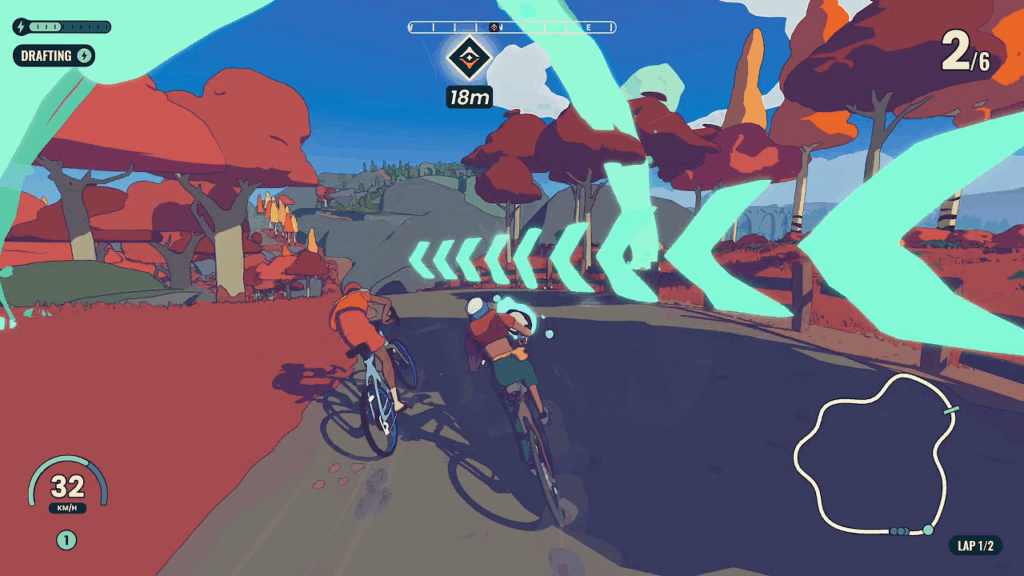
Soon after beating a gang of rowdy delinquents in a race that teaches Wheel World’s fundamentals, the rusty bicycle feels inadequate for the challenges presented to Kat and Skully. To stay competitive, they must earn new parts they can swap in an instant onto the bicycle. These parts provide statistical advantages and disadvantages to four categories: Power, Aero, Handling, and Grip.
An interesting choice made for these four categories is, among a few other effects, all contribute to the bicycle’s total speed. A handy tooltip on the Bike menu explains. Power determines the bicycle’s acceleration and its speed when moving uphill. Aero improves its maximum speed. Handling reduces speed lost during Wheel World’s many tight turns. Finally, Grip reduces the speed lost from collisions and other mistakes. When every component contributes to the bicycle’s total speed, it makes the choice to ignore any of them a foolish one. While it’s tempting to build the bicycle to focus on a high Power or Aero value, I learn that one with more harmonious statistics is more effective at maintaining a high speed in all kinds of scenarios. To reinforce this point, once Kat and Skully reclaim all the lost legendary parts, the restored bicycle has perfectly balanced, middle-of-the-road stats that makes it dominate every race in which Kat rides.
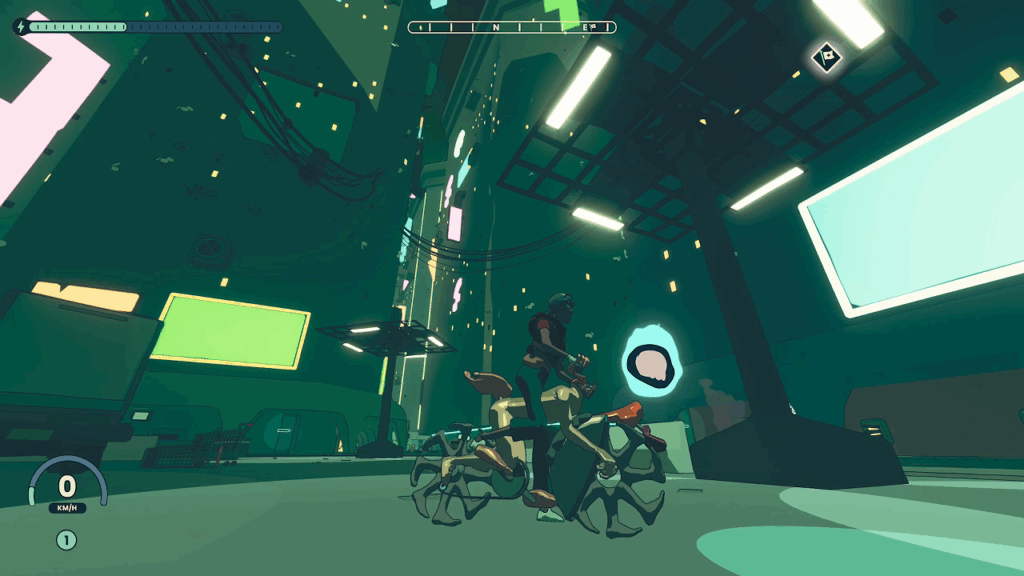
While most of the bicycle parts Kat and Skully earn across Wheel World are ordinary and almost imperceptible once equipped onto the bike, a few are more visually distinct. The Hot Dog set wraps the bicycle frame in a novelty weiner in a giant bun, transforming Kat into a volunteer sausage advertiser. Late in their mission, the pair can acquire the Synthetic parts, a futuristic amalgamation incorporating obvious electronic wires and wheels with curiously off-center centers. Most memorable of all is the Body set that transforms the bicycle into a grisly apparatus featuring a disembodied torso for the frame, feet assembled into a kaleidoscope for wheels, and an open palm that cups Kat’s bottom for a seat. There’s some fun to be had in riding around with these unusual parts, but they often place the bicycle at a statistical disadvantage compared to more conventional parts. There is sadly no option to apply parts on a cosmetic level. If I want the appearance, I must also accept the performance.
The main purpose for earning and equipping new bicycle parts is to compete in successively more difficult races. Kat and Skully encounter gangs of rival racers lounging around Wheel World. If she dismounts her bicycle and approaches them, she may challenge them to a race. Most races are conventional circuits of two or more laps around a localized part of the world, though a few—particularly the “boss” races against the legendary part thieves—are point-to-point marathons that cover large portions of the map.
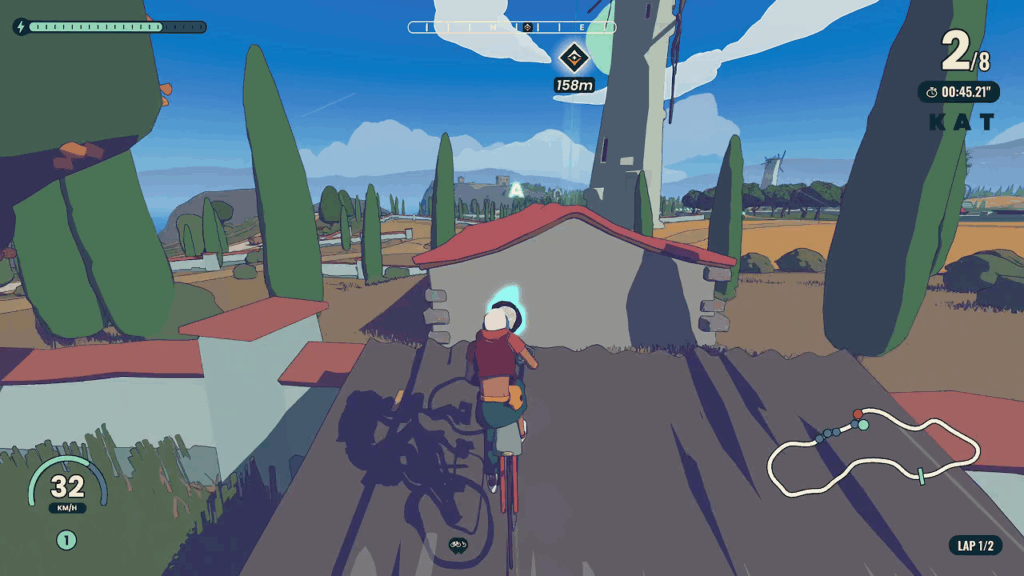
To keep things interesting, Kat and Skully are given multiple goals to complete in every race. Finishing in first place and in the top three are the two traditional racing goals. A third goal tasks the pair with beating the course record set by a mysterious figure known only as Tom. With a few exceptions, these time trial goals are surprisingly easy to beat once the pair assemble a decent bicycle. The final goal is usually the most difficult. While racing, Kat discovers letters that spell out her name, often placed at the top of jumps, at the end of difficult obstacle courses, or hidden on the inside of tight corners. Each race’s final goal is to collect all three letters while also finishing the race in first place. Most of these four goals may be completed in a single race, though a few are challenging enough that they take multiple attempts.
When Kat finishes any of the goals in a race, she earns Rep. Rep is the most important resource in Wheel World. It is the measure the bicycle-obsessed denizens of the land use to judge each other. The proudest and most experienced bicyclists will ignore Kat until she earns enough Rep—including the bicycle thieves. Kat is unable to win back the legendary parts until she has earned enough Rep for them to even acknowledge her challenge.
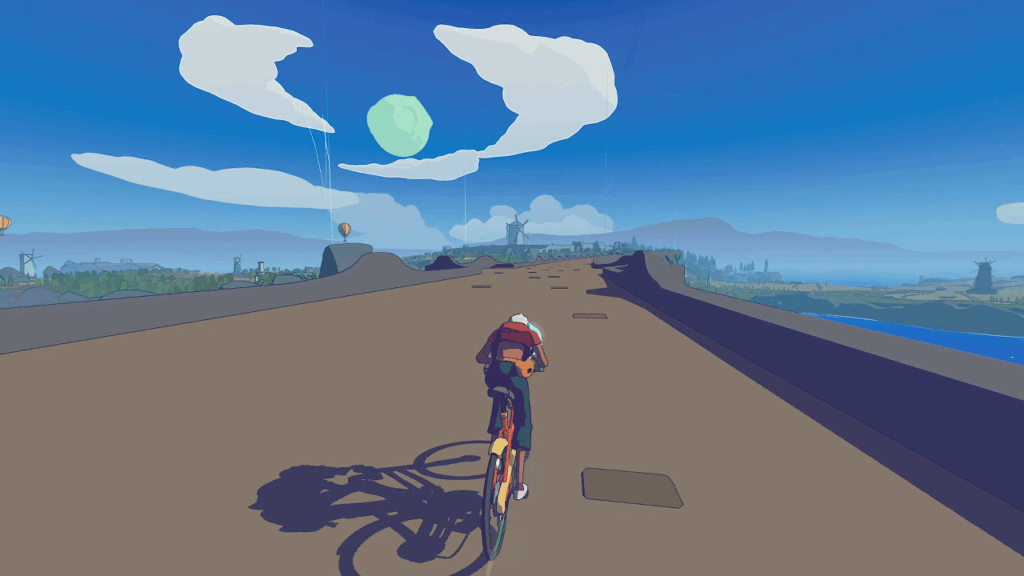
All of these races take place across Wheel World, a multifaceted pastiche of France, the popular face of professional cycling. At first the world feels small as Kat begins the story confined to a small island. Once she wins her first race, she is allowed to cross a colossal, ornate stone bridge and given free rein to explore the rest of the countryside. It consists of stereotypical and quaint images of the French countryside. A walled city serves as a nexus Kat must repeatedly cross as she earns Rep in a farm country dotted with pastures and tiny villages, a peninsula filled with windmills and wineries, and a large forest crisscrossed with natural trails and a long, winding asphalt road for automobile traffic. Only by competing in all three of these outlying regions will Kat earn enough Rep to compete in the hardest challenges set in the central city.
The atmosphere created in these zones does much to set Wheel World’s tone. Though the environment seems locked in a warm, bright summer day, the color palette applied to the cel shaded graphics is still subdued and washed out. The soundtrack has driving, high-tempo beats befitting a racing videogame, but instead of loud instrumentation, races are scored by quiet electronic tracks and pleasant vocals singing in a language I do not understand. The overall audiovisual effect suffuses Wheel World in melancholy, creating a mild and relaxing mood even as Kat and Skully compete in increasingly fast and dangerous races to complete their mission.
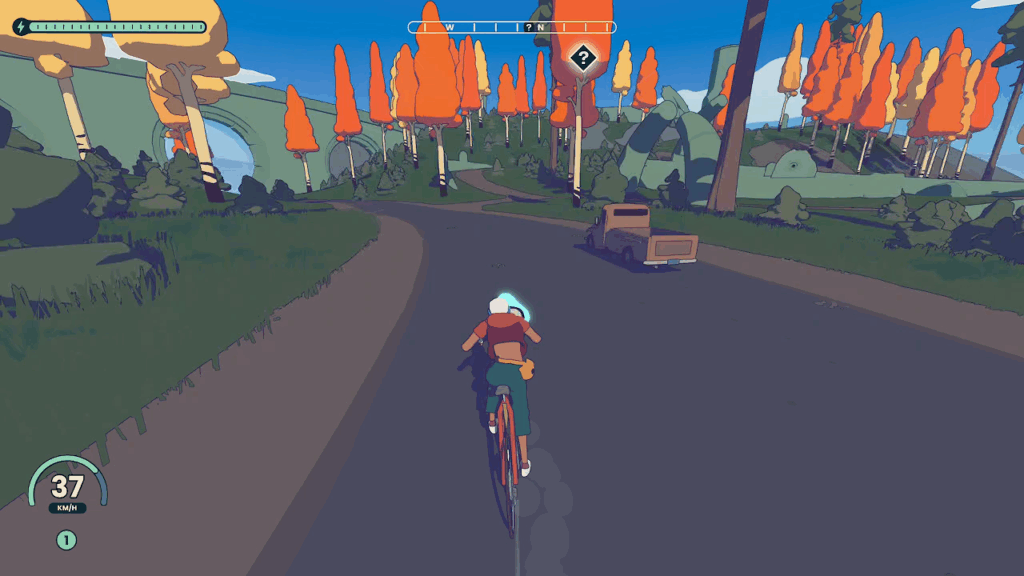
Thanks to these aesthetic flourishes, it is often more enjoyable for Kat and Skully to wander around Wheel World than to participate in its many races. There are few places they are not allowed to go, and the barriers they encounter feel real and logical, like the walls around the central city and the sheer cliffs above an ocean at the edges of the outlying regions. While Kat and Skully ride on these pleasant and aimless cruises, they discover many of Wheel World’s optional open-world activities.
A primary goal given by Skully to Kat early in their adventure is to reach all of Wheel World’s bell shrines. There is one of these domed towers located in each region, and while they are easy to spot from a distance, the roads leading up to them can take some cunning to discover. Reaching the summit of a tower and ringing the bicycle’s bell summons one of Skully’s fellow immortal bike daemons, who reward the pair for their visit with a modest increase to their boost meter and a map of the local area.
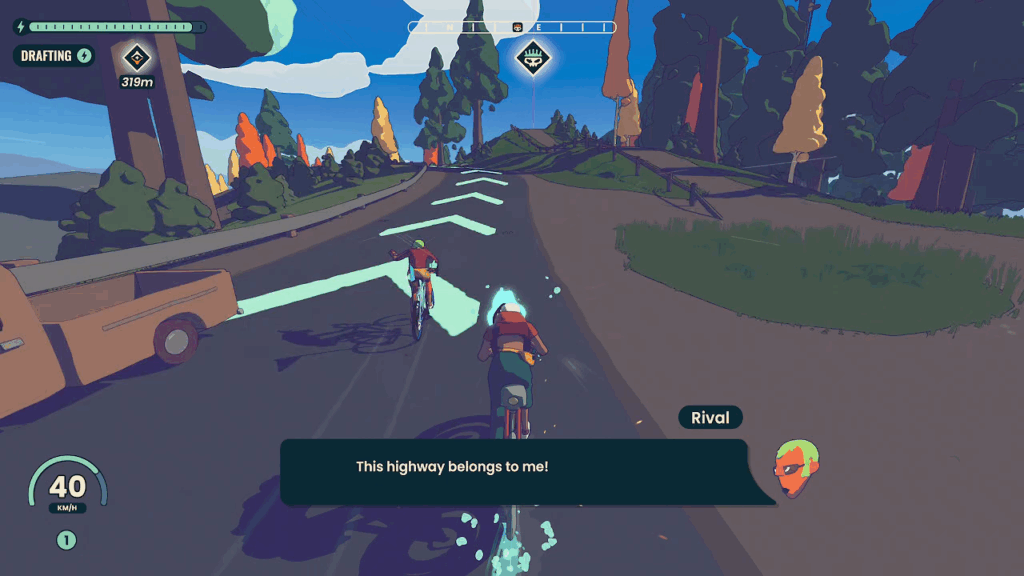
Other open-world goals require a little more effort and exploration. Boxes strewn around every area contain additional bicycle parts. A bizarre man wearing a box on his head will highlight some of them on Kat and Skully’s map when spoken to, but most must be found through pure wandering. Ramps, strategically placed in front of fences, packing crates, and small buildings, can be leapt from; many are found during races, but not all, requiring some off-roading to discover. Chains of mysterious stone rings dot the landscape, marking a secret course Kat and Skully must follow. The most illusive are the Lone Wolf cyclists, taciturn riders found circling small parts of the map recognizable only by the strange green aura they generate. Ringing the bicycle’s bell near one of these riders plunges Skully and Kat into an impromptu, one-on-one race. Though Skully and Kat are gifted maps at the bell shrines, none of these activities are actually marked on them, requiring effort and care to discover them all.
All of Wheel World’s activities are tracked in a Sidegigs menu, where Kat marks off her progress on cards. Marking every box on a card and delivering it to a sketchy drone rewards her with coupons she can spend on bike parts around the city. Recovering Skully’s lost legendary parts and completing the Chain of Life is a moderate challenge that takes about six hours of playtime. Tracking down every collectable on the world map and turning in every Sidegig is Wheel World’s true ultimate feat and will take many hours more to accomplish.
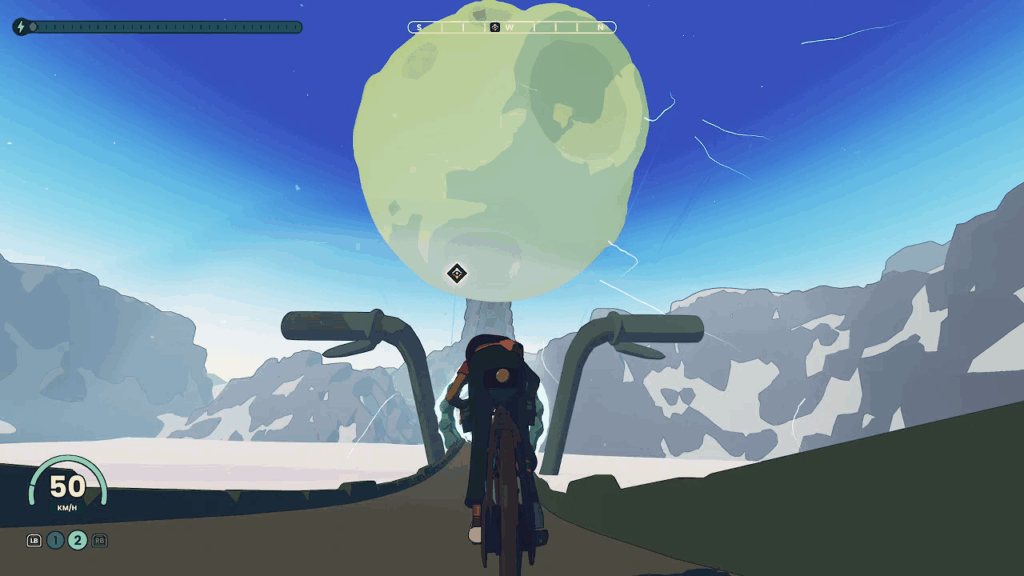
Wheel World is an enjoyable swoop through a picturesque countryside. It doesn’t excel at any particular element, but I found myself engaged and entertained throughout. The one aspect of its design I single out for praise is its serene atmosphere. Though the interruption of Skully’s mission is a dire threat to Wheel World’s natural order and the racing does not sacrifice a sense of speed and urgency, the choice of color and music ensures I never feel rushed. I never enjoy feeling rushed in an open-world videogame, preferring to feel welcome to explore it at my leisure and in the order I choose. In the back of my mind, I know Kat and Skully should be earning Rep and reclaiming the stolen legendary bicycle parts. I am just as happy to steer them over the next hill just to see what is there, enjoying the chill music, melancholic colors, and relaxed pace.